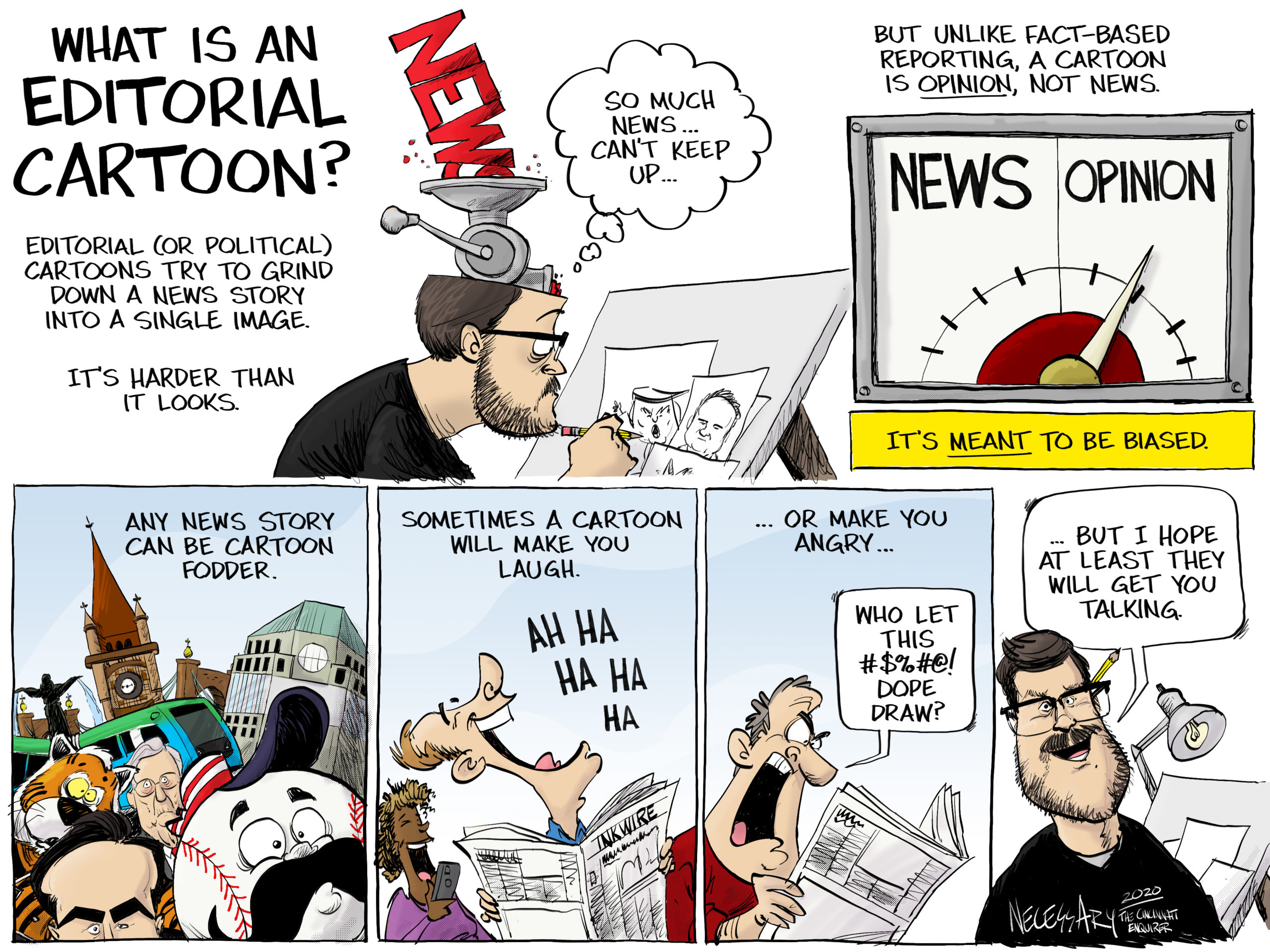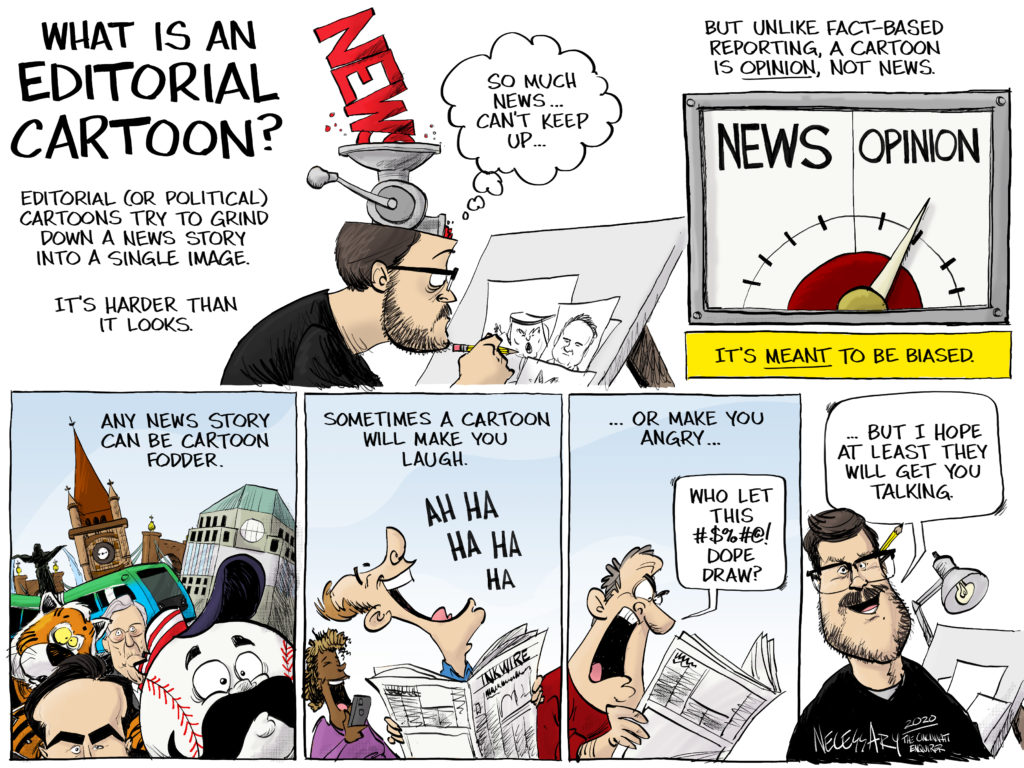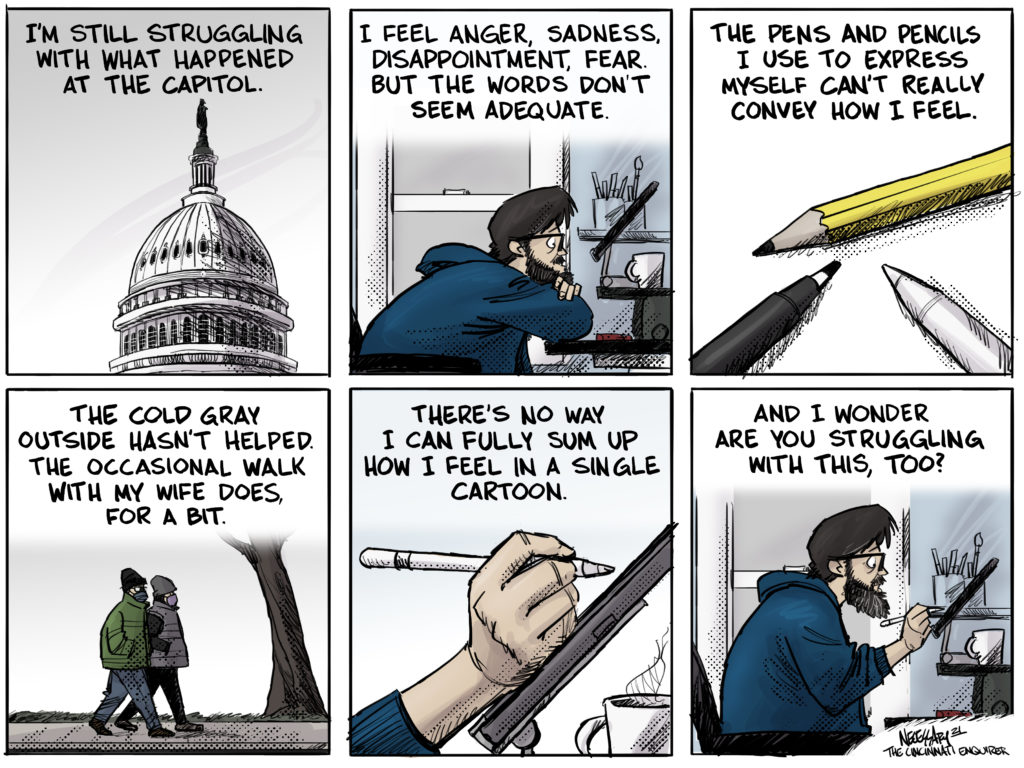Within months of each other this year, both the president and vice president of the Association of American Editorial Cartoonists lost their jobs, a commentary, if there ever were one, on the state of cartooning in a financially devastated newspaper industry.
After three years as the paper’s first and only editorial cartoonist, Kevin Necessary, the vice president, left his job at the Cincinnati Enquirer because of budget cuts.
This summer McClatchy newspaper laid off three Pulitzer-winning cartoonists: Jack Ohman of the Sacramento Bee, Joel Pett of the Lexington Herald-Leader and Kevin Siers of the Charlotte Observer.
Ohman, president of the Association of American Editorial Cartoonists, told The Washington Post he was “stunningly blindsided” by his firing in July. He was the only person at the Bee to be laid off.
Necessary estimated there were several hundred staff cartoonists in the mid-20th century but now only a handful work full-time at newspapers, which is losing papers at a rate of two per week in 2022.
“Editors and publishers, whether it’s newspapers or news sites or anything like that, I don’t think they have a good grasp on why this work is valuable,” Necessary said.
Necessary’s cartoons included this one – one of his most popular – that depicted the mascots of the Cincinnati Bengals and the Buffalo Bills kneeling on the field after Bills safety Damar Hamlin collapsed after tackling Cincinnati wide receiver Tee Higgins in January. He also illustrated cartoons about gun violence, COVID, and local elections.
Newspaper cartoons are going extinct, the result of shrinking newsrooms, the rise of social media and popularity of online memes.
“There are no jobs available because newspapers aren’t hiring for editorial cartoonists,” said Rob Snyder, who worked as an editorial cartoonist for the Baltimore Sun in the late 1980s. “When newspapers began to cut positions in its editorial department 20 years ago, cartoonists were the first to go..”
Editorial cartooning dates back to the year 1754. Good editorial cartoons are made up of a combination of good writing and clear drawings. Five other elements are also used to put these cartoons together. These elements are labeling, irony, exaggeration, analogy, and symbolism. They are meant to have the ability to draw in the audience within a few seconds and deliver a message without confusion.
“A well-known cartoon is like a drive-by shooting,” Snyder said. “It’s easily digestible, often humorous and doesn’t require slogging through some editorial writer’s boring argument that trips all over itself in some effort to appear balanced or reasonable.”
But the decline of newspapers has drastically changed the landscape, said Jenny Robb, head curator of Comics and Cartoon Art at The Billy Ireland Cartoon Library & Museum at the Ohio State University.
“I got bumped from more and more papers and I was barely holding on. I don’t even count how many papers. It’s kind of depressing,” said Lalo Alcaraz, the cartoonist behind “La Cucaracha.” Last year, Alcaraz was the first non-white person ever to win the prestigious Herblock Prize.
Social media – and the way people engage with news – also has contributed.
“Social media is where many find their news, their memes, their political images,” said Signe Wilkinson, longtime editorial cartoonist for the Philadelphia Inquirer and Philadelphia Daily News who retired from the papers in late 2020.
Unlike social media, newspapers were generally read by a wide variety of people, she said, “so many eyeballs with many different opinions would see the cartoons.” That’s not the case anymore. “Now eyeballs silo the news they get and see what they already agree with.”
Snyder said he’s also noticed a change in content and style, a reflection of the audience itself. “Americans aren’t as culturally literate as they might have been even 60 years ago,” he said. “Would they get a joke that riffed on a Biblical or literary theme? Cartoons too often now appear to depict news announcers from TV news or a couple sitting on a couch commenting on something they saw on TV.”
Although social media users may lump memes and editorial cartoons in the same category, cartoonists said they most definitely are not.
“I’m against people calling editorial cartoons a meme,” Alcaraz said. “it kind of cheapens what we do.”
Those within the cartoon field have a wide range of different opinions on the art form now and its purpose and how it is viewed by others.
“The perspective of the way that comics are viewed has changed a lot. Comics were really viewed as something that was just for kids at the start of the last century but now especially after the emergence of graphic novels. People have realized that this is a very powerful art form,” said Caitlin McGurk, curator of Comics and Cartoon Art and an associate professor at the Billy Ireland Library & Museum.
The problem is finding people to see them.
“I hope there will be new places for our cartoons to be seen by wide audiences but don’t see those places right now,” Wilkinson said.
Angel Lasha Godfrey is a student in journalism and international affairs at the Ohio State University. An earlier version of this story was published in the summer 2023 print magazine. It has been updated.


